X-MEN #1 (Marvel Comics, $3.99)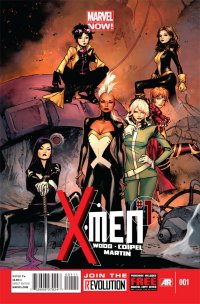
By Devon Sanders (@devonsanders)
Jubilee may or may not be a vampire in X-Men #1.
Writer Brian Wood doesn’t even mention it. Comics and the world are all the better for it.
The X-Men are a team and yes, this comic is comprised of nothing but members of The X-Men who also happen to be women.
Brian Wood doesn’t even mention it; just gets on with doing a great job of portraying superheroes doing kick-ass things. Comics and the world are all the better for it.
Brian Wood just wants to keep it moving. We need more of this guy.
Jubilee is on her way to Westchester, New York, home to The Jean Grey School For Higher Learning and The X-Men. Jubilee has a baby. Jubilee has a baby but shouldn’t have this baby. Things are complicated. This baby may be the key to the end of the world and a young lady who may or may not be a vampire is riding a train and heading towards The X-Men with a new immortal enemy in pursuit. I love comics.
I do. X-Men #1 makes you love comics.
Wood, with X-Men #1, should be considered one of comics’ more inspired creators. Continuity can be a burden and Wood overcomes this brilliantly. There is, of course, continuity involved here but Wood’s greatest skill is that he never weighs the story and more importantly, the reader down with any of it. Wood establishes history through dialogue and characterization; a rare and valued skill in today’s current climate.
Artist Olivier Coipel is frankly, a treasure. Coipel is one of maybe three artists who if they do anything, gets my money. His characters occupy interesting spaces and his figure work is simply gorgeous. Every panel is just sooooo damned pretty. How he manages to make every panel look flawless while simultaneously servicing the needs of the story is always beyond my understanding. The man is obviously some sort of art-casting wizard.
X-Men #1 is the rare comic that was worth the wait and more. Wonderful characters, a story that makes you want more and an artist at the top of his already considerable game. X-Men #1 is a comic that has what it takes to take my money.
Rating: 




Out of a Possible 5 Stars
 Godzilla: The Half Century War tpb (IDW, $19.99)
Godzilla: The Half Century War tpb (IDW, $19.99)
by Graig Kent
Like most film/comic book/genre nerds, I have a soft spot for Godzilla movies (the 1998 US abomination obviously excepted). They’re appreciatively cheesy, containing a level of craftsmanship in the miniatures that is worth admiration as well as the cathartic glee of watching it all get destroyed. Beyond the first film the stories don’t even broach anything resembling meaningful, but they’re frequently imaginative and, more importantly, visually stimulating.
Godzilla as a character is, well, not much of a character. It’s an epic force of nature, pure incomprehensible ID. You really can’t center a story on the creature you have to base a story around it, the same way you can a tornado or earthquake or any other type of natural disaster. As a result, a Godzilla story can be quite serious, if taking the human angle the disaster causes to people and families. More often than not, though, Godzilla stories are unscrupulously silly, centering around other monsters entering the fray and the resulting fights taking focus. But the king of all monsters is versatile enough to handle both extremes
Writer/artist James Stokoe employs both with The Half Century War, as he manages to deliver impressive, decades-spanning epic that’s equal parts character study and ridiculously cool kaiju big battles. I can’t claim to be an expert — though I have seen the majority of the Toho features — but this is possibly the best Godzilla story I have experienced. I would put it up against any of the films for delivering a meaningful, engaging story, as well as exhibiting giant monster combat that is equal to any seen in moving pictures.
Originally presented as a 5-issue series, the story starts in 1954, with each chapter taking place in a subsequent decade. The opening chapter takes place in Tokyo when Godzilla makes his first appearance. Lieutenant Ota Murakami and his tank driver Kentaro are on hand to witness the rampage, and are instrumental in distracting the creature and driving it back into the bay. Their undeniable impact and bravery in the field sees them recruited to the newly formed Anti Megalosaurus Force (the “AMF”) which would over the decades grow to become a multi-national, specialized task force, armed with specialized weaponry and two-man teams dedicated to each kaiju that appears.
Stokoe introduces plenty of ideas and characters into the series but presents it all from Ota’s point of view as he grows old fighting a monster that he inevitably understands he cannot beat. There’s an element of studying the creature’s behavior, but as Ota learns, there’s not much to understand. Stokoe also wisely builds in a human antagonist, by way of Dr. Deverich, an ex-AMF scientist who took his research and broke off on his own, creating devices which can affect the monsters and selling them to the highest bidder. As in any great disaster story, having human opposition beyond just the disaster raises the stakes for the character, and Stokoe tying the human antagonist with the disaster brings it all together very, very nicely. Just as remarkable, the stakes of The Half-Century War increase with each globe-spanning chapter, and Ota grows wiser and more introspective with age. Stokoe’s choice of locales — Vietnam, Ghana, Bombay and the Antarctic — are notable in their diversity, as is the AMF team.
Visually, the series is a marvel. Stokoe’s attention to detail is remarkable, as complex (probably moreso) than the wonderful Toho miniatures, and as eye popping as any CGI or anime could likely muster. There’s full-page and two-page splashes aplenty, but the level of detail in every panel, the fact that he can squeeze so much wonder onto every page, tickles the pleasure centers of the brain continually. I’m not necessarily a fan of manga, and the only weak aspect of the book for me is the manga-fied character faces. They’re appropriately expressive, but it’s just not an aesthetic I key into. Otherwise, we have a comic book that features every notable monster in the Toho stable, and a story that, in my mind, gives this summer’s Pacific Rim something to measure up to.
Rating: 




Out of a Possible 5 Stars
The Bounce #1 ($2.99, Image)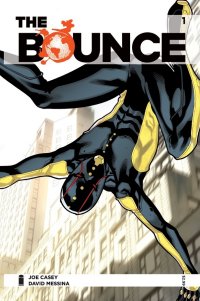
by D.S. Randlett (@dsrandlett)
The first issue of Joe Casey’s Sex confounded my typical expectations of a first issue from Image, much less a first issue of one of their latter day superhero series. It stepped right into its story with an assured grasp of character and place. FIrst issues from Image are usually a bit too timid with stepping into their worlds, or else they assume too much. In either case, these first issues usually concern themselves with their chosen genre, sometimes an idea for the plot to revolve around, rather than their own narrative. In effect, the first issues are not really beginning so much as they are previews with cliffhangers. If I haven’t been invited fully into your narrative, why would I care about the cliffhanger that’s starting the story in earnest, when the story really should have begun on page 1?
Sex’s divergence from this trend made me excited to check out Joe Casey’s next original offing, this week’s The Bounce. The ads and previews for this series were a bit more cagey than the ones for Sex, but they shared the same deft design sense and transgressive feel as that series. The Bounce is a superhero book that heavily involves another subject taboo for the superhero genre: drug use. The Bounce is refreshingly non judgmental about its protagonist’s affection for marijuana, but then you don’t really get the sense of what role pot plays in his life. Does it give him his powers? Does it keep him from being a better superhero? All we see is the hero getting blazed, seeing a new report about a hostage situation, and then him getting out there to deal with it.
This first issue is definitely far less assured than that of Sex, falling somewhere between that comic and what we usually see from Image. There’s an action beat in the beginning, and then some exposition that’s not really related to the protagonist. Casey does a fine job of clearly laying out the world and the ideas that he wants to explore (think parallel universes), but fails to present that information in terms of the set of eyes that we’re supposed to be viewing those ideas through. The end result is a story that is smart and in a lot of respects well crafted, nearly impossible to connect with. The tone is striving for a sense of fun immediacy, but it ends up feeling a bit like a clinical exposition dumps for large stretches. In the end, you just don’t feel the stakes.
If The Bounce has a saving grace, it’s the art. This is a really good looking book. David Messina has a style reminiscent of Tony Harris, but with a more assured eye for action storytelling. There’s also something subtly, but wonderfully, transgressive about his costume designs. The Bounce himself is pulling a lot from Spider-Man’s look, but there’s sort of a kinkier spin to it, and red eyes for a superhero who smokes tons of pot is a perfect touch.
Despite some of my reservations, there is a lot of potential here, even if it’s not fully present right out of the gate. In another three issues or so, this might really be something.
Rating: 




Out of a Possible 5 Stars
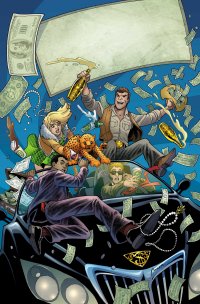 The Green Team #1 (DC Comics, $3.99)
The Green Team #1 (DC Comics, $3.99)
Occupy Comics #1 (Black Mask Comics, $3.99)
By Adam Prosser
“Class Warfare” is a term that gets thrown around a lot these days, but it’s almost always used to describe poor or middle-class people who criticize the wealthy, rather than vice versa. Warren Buffet has said something to the effect that, if there is a class war in America, his class, the rich, are winning. Nevertheless, hating on the rich is easy to do, and it’s hardly a new phenomenon in pop culture. As I pointed out in my review of DC’s The Movement a few weeks back, we’ve seen no shortage of evil corporations in pop culture, even though the movies and TV shows and video games and comics that promote this viewpoint are generally made by gigantic multinational corporations themselves.
This context creates problems with The Green Team, the new DC book that’s being presented as sort of an inverse companion to The Movement. The latter book is a populist tract that borrows the imagery of the Occupy movement and Anonymous; this new book is about a gang of “Teen Trillionaires”, whose leader is essentially Richie Rich with a dash of Elon Musk. They’re a revamp of one of seemingly dozens of comic book “kid gangs” created over the years, this particular group by Joe Simon (in his wacked out 70s phase) and Jerry Grandenetti. (And if you guessed that neither Simon nor Grandenetti’s name appears anywhere within this book, give yourself a gold star!) but writers Art Baltazar and Franco–just Franco–are determined to make them relevant. They’re seen through the eyes of prospective new member Mohammed Qahtanii, an Arab prince, who attends an underground expo named “POXPO” (?) where scientists can tout their semi-legal wares for prospective founders. The biggest potential “fish” for all this is Commodore Murphy, a teenager already worth billions and with a multi-trillion dollar trust fund waiting for when he comes of age, who organized the expo in the first place, and who’s the big-thinking founder of the Green Team. Along with JP Huston, the scion of an oil baron, and Cecilia Adams, a teen movie star (gender-swapped from the original!) Plus Huston’s sister Lucia Lynn, the team seems to be looking for inventions that can better humanity’s lot, but this takes a backseat when a gang of seemingly populist supervillains calling themselves the Riot Act invade the show, and Murphy breaks out his new technology–an armoured suit that’ll allow him to become a superhero. Maybe.
Now. As with The Movement, a book I’m already starting to feel a bit ambivalent towards despite my 4-star review, I have to append the caveat that this is just a first issue, and exactly what this comics’ precise worldview and themes are going to be is still a little up in the air. So I run the risk of criticizing a book for ideas that it’s not actually trying to convey. Nevertheless…it’s awful hard to get away from the fact that this book is wholeheartedly embracing the idea that rich capitalists are heroes, and that its villains are, yes, waging “class warfare”, spouting anti-1% rhetoric and embodying the wealthy man’s fear of the masses. I know, I know…there’s no reason rich guys can’t be heroes, as all us Batman and Iron Man fans know; and there’s no denying that history has shown that the masses, if sufficiently riled up, can commit some pretty bald atrocities against the ruling classes, from the French and Communist revolution to the way modern acts of terror are usually perpetuated by the suffering and desperate.
So there’s a potential here for a real exploration of ideas, and the thing is, in many ways this is a well-crafted comic. Baltazar and Franco do a great job of setting up the various personalities with a few quick strokes, and the conflict is set up quickly and efficiently. The art by Ig Guara is expressive and actually jibes well with Amanda Conner’s cover, though I don’t feel like Guara’s made full use of the potentially fun setting, mostly making it look like an airplane hangar or warehouse. Mostly, though, it’s an effective comic…it’s just, in this age where people are losing their homes and America’s infrastructure (both physical and economic) is crumbling because a few monstrously wealthy gadabouts decided to play roulette with other people’s money, is this really the comic we need?
On the other end of the spectrum, we have Occupy Comics #1, a kickstarted indie comic whose funds will be used to 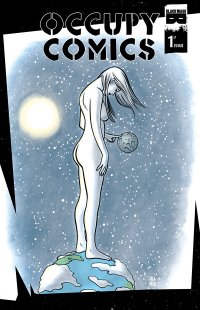 raise money for Occupy-related causes, so there’s no question where it stands on the issues. It also features a murderer’s row of comics talent, including Alan Moore, David Lloyd, Ben Templesmith, J. M. DeMatteis, Molly Crabapple, Art Spiegelman, and a cover by Mike Allred. It must be said, though, that a lot of the big name offerings aren’t “comics”, they’re illustrations or (in Moore’s case) an extended text piece. Most of the actual comics are by lesser lights, like a story from the early history of labour struggles by Joshua Hale Fialkov and Joseph Infurnari, or an odd little one-pager by Ronald Wimberly about gas thieves. There’s also a piece by Matt Pizzolo and Ayhan Hayrula that links the Occupy movement and the Tea Party, complaining that both have been the victim of media misrepresentation, which I can’t help but think will ruffle some feathers on both sides of the aisle. My favourite pieces are a heartfelt illustrated monologue by DeMatteis (art by Mike Cavallero) that lays the whole issue out in more personal and less political terms, and a small but elegant little comic by Ales Kot, Tyler Crook, and Jeromy Cox–practically an instruction guide–on being a citizen journalist. Moore’s lengthy text piece, “Buster Brown at the Barricades”, is an overview of comics history that loudly eschews the traditional Scott McCloud-esque formal overview and looks at the history of subversion, satire, and rebellion in comics form. (He even, amusingly, manages to shed some new light on the by-now tired link between comics and ancient Egyptian heiroglyphs.)
raise money for Occupy-related causes, so there’s no question where it stands on the issues. It also features a murderer’s row of comics talent, including Alan Moore, David Lloyd, Ben Templesmith, J. M. DeMatteis, Molly Crabapple, Art Spiegelman, and a cover by Mike Allred. It must be said, though, that a lot of the big name offerings aren’t “comics”, they’re illustrations or (in Moore’s case) an extended text piece. Most of the actual comics are by lesser lights, like a story from the early history of labour struggles by Joshua Hale Fialkov and Joseph Infurnari, or an odd little one-pager by Ronald Wimberly about gas thieves. There’s also a piece by Matt Pizzolo and Ayhan Hayrula that links the Occupy movement and the Tea Party, complaining that both have been the victim of media misrepresentation, which I can’t help but think will ruffle some feathers on both sides of the aisle. My favourite pieces are a heartfelt illustrated monologue by DeMatteis (art by Mike Cavallero) that lays the whole issue out in more personal and less political terms, and a small but elegant little comic by Ales Kot, Tyler Crook, and Jeromy Cox–practically an instruction guide–on being a citizen journalist. Moore’s lengthy text piece, “Buster Brown at the Barricades”, is an overview of comics history that loudly eschews the traditional Scott McCloud-esque formal overview and looks at the history of subversion, satire, and rebellion in comics form. (He even, amusingly, manages to shed some new light on the by-now tired link between comics and ancient Egyptian heiroglyphs.)
This is all very well, and I applaud this book’s existence, but when I said this book is like the flipside of The Green Team, I meant it. That includes the fact that it’s a moral, passionate work with its heart in the right place–but with questionable entertainment value. Of course, there are other reasons to read comics besides watching dudes smash through brick walls, and it’s not as though there weren’t moments that brought a smile to my face, but this comic does smack a bit of eating your vegetables. I guess that’s partly because I’m seated squarely in the choir to which this comic is preaching. But hey, if anyone picks up this comic who didn’t already know just how shamelessly the titans of the financial sector screwed us over, and continue to screw us over (as outlined in Joshua Dysart, Kelly Bruce and Allen Gladfelter’s “Casino Nation”), I doubt they’ll be bored reading this.
So: a book published by a massive corporation that takes an anti-populist stance while shooting for mainstream entertainment, and an activist indie work that aims almost purely for the intellect. The divide has never been clearer.
The Green Team #1: Rating: 




Out of a Possible 5 Stars
Occupy Comics #1: Rating:





Out of a Possible 5 Stars
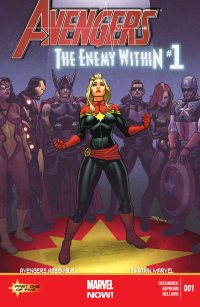 Avengers: The Enemy Within #1 (Marvel, $2.99)
Avengers: The Enemy Within #1 (Marvel, $2.99)
By Jeb D.
It’s a weird sort of time for Marvel fans. On the one hand, their “non-core” titles are as strong a lineup as they’ve had in years (Young Avengers, Hawkeye, FF, Daredevil, Journey Into Mystery, X-Factor, Fury MAX, etc.). On the other hand, their burgeoning brand-expansion/media tie-in efforts are plastering the Avengers, X-Men, and Wolverine logos across so many comics that it’s nearly impossible to sort out what you “need” to read to keep up with what’s going on, and what you might actually enjoy as a satisfying comic experience. So, you start to figure out which creators are going to work worthwhile variations on familiar tropes (I’ll echo Devon’s praise for Brian Wood, along with names like Fraction, Hickman, and Aaron), but you also look for those voices that work best (or at least most often) on the fringes, and from Kieron Gillen to Kathryn Immonen, there’s plenty worth reading. Now and again, of course, one of those voices winds up having to straddle the worlds of the niche title and the name-brand franchise, and thus we come to Kelly Sue DeConnick’s Avengers: The Enemy Within, in which her successful makeover of Carol Danvers, from Ms. Marvel to full-on Captain Marvel, runs headlong into Avengers Assemble, one of the multitiudes of Marvel’s “didn’t I see these guys in the movies?” titles.
DeConnick had barely got her feet under herself on Avengers Assemble before it was hijacked for a pair of Age of Ultron tie-ins (an “epic” I have to keep reminding myself even exists), and the first installment of this five-issue crossover between that title and Captain Marvel suggests an uncomfortable pairing.
DeConnick’s Captain Marvel has been a character and dialogue-driven book, and its place on the outer reaches of the Marvel product line has allowed Carol Danvers to interact with a variety of characters from outside the usual spandex sandbox; in keeping with her test-pilot backstory, she’s time-traveled to meet female flying aces of WW2, and encountered the Marvel Universe version of the real-life “Mercury 13” women astronauts. Blending the necessities of plot exposition with the garrulous nature of these female pilots has often allowed the Captain Marvel series to transcend a level of talkiness that might sink another book: there is much information, and emotion, to be conveyed, and DeConnick’s characters carry it well.
But an Avengers-based book is really not the place for that kind of logorrhea: given the long history of Carol Danvers and her fellow Assemblers, we would expect their exchanges of dialog to be more or less to the point. Yes, Carol’s got problems to share: a brain lesion threatens to end her life if she attempts to fly under her own power (which I more or less suspect of being a way to save a few bucks on the eventual big-screen version of the character), but she and Jessica “Spider-Woman” Drew know each other well enough at this point that having them harangue the subject for an entire issue, even (especially?) one that features plenty of fighting and slamming and bashing and FWOOOM-ing, gets a little tiresome, once the point is made (particularly for those who’ve seen it already talked through in the last few issues of Captain Marvel). Danvers and Drew were key supporting players in Brian Bendis/Michael Gaydos’ Alias, and that series helped place them at the forefront of a new brand of female superheroes: sharp, (relatively) down-to-earth, capable at tasks beyond super-bashing, and being no more hopeless at relationships than their male counterparts. But to keep the conversation going, DeConnick seems to feel that this issue has to be laden with arch quippiness (“How can you know that?” / “Spidey-sense.”/ “You don’t have Spidey-sense.”/ “Neither do you!“) and dramatic pronouncements (“I’m not going to let anything happen to you!“) that, at this point, feel retrograde. This issue also introduces the first of the movie-familiar Avengers that will share the series with Carol, and the cutesy exchanges between Carol and Thor (“You like hitting stuff with that hammer of yours.” / “It is an act of which I am singularly fond.“) don’t bode well for the upcoming appearances of Cap, Tony, etc. It’s encouraging that the underlying story seems to hinge on the importance to Carol of more or less “real” people (as opposed to Skrulls or zombies); no complaints so far on the plotting. But as we move forward, I’m hoping for something closer to DeConnick’s more “grounded” (so to speak) Captain Marvel series than the wacky-action Avengers Assemble.
While I approve of Carol ‘s new look, taking her out of the stripper outfit she wore for years, the deliberately pinched, angular artistic style that has characterized the Captain Marvel series, beginning with original artist Dexter Soy, hasn’t particularly appealed to me (better that than the overt “fan service” of a Frank Cho, I suppose, but a middle ground would seem to be possible). Artist Scott Hepburn opens things up a bit, and his work on the amusingly cheesy Grapplers (or as Carol puts it: “The Grapplers? Lady wrestlers turned super-villains. You’re putting me on.“) is engagingly sly without undercutting their super-powered lethality; he also knows how to stage an all-female super-brawl without turning it into a sleazy catfight. Colorist Jordie Bellaire breaks away from the muddy color palette that Soy introduced, so this book almost has some of the grandeur you want from a title featuring Earth’s Mightiest Heroes.
It’s more or less par for the course to hope that a creator can use this sort of crossover with the A-team to attract new readers to a fringe title like Captain Marvel, so yeah, I’d like to see that happen. But I’d also like to see this crossover find a tone that doesn’t swamp that book’s virtues in a barrage of word balloons and snarky wisecracks.
Rating: 




Out of a Possible 5 Stars
The Steam Engines of Oz Free Comic Book Day/#1 (Arcana, Free/$3.99)
by Graig Kent
It seemed that far too many review’s for Sam Raimi’s recent Oz: The Great and Powerful unkindly and/or unfairly compared the film against MGM’s 1939 musical. In the 70-plus years since, that version of the Wizard of Oz has become iconic, the ultimate representation of the Oz series, and for most, it seems, the only representation. Oz’s creator L. Frank Baum scribed 14 novels and a great many short stories, as well as musicals and a newspaper serials based off his creation. After Baum’s death the series continued from his publisher, about 50 total volumes.
All of Baum’s contributions are long in the public domain, which explains the seemingly endless proliferation of Oz stories. The public domain allows for others to play with Baum’s toys in their own way, whether they want to do so sticking to the series continuity (or closely to it at least) or go off wildly in another direction. Unfortunately most iterations seem to play almost solely with the MGM interpretation, deviating off the familiar “off to see the Wizard” arc (of which the movie only adapts two-thirds of, at best).
I was wary of The Steam Engines of Oz, concerned that it would just be a steampunk variation of the all-too-familiar journey along the yellow brick road. Mercifully writers Eric Hendrix and Sean Patrick O’Reilly are using Oz in a fresh manner but keeping the feeling of the marvelous land alive. One can come into this Oz entirely clean or well-versed in the lore and still enjoy the story that is laid out, as it is in most respects still adhering to the adventure structure that Baum established.
Though non-canonical, Steam Engines fakes its way into being set a generation or two removed from the Wizard of Oz, with the Scarecrow and Tin Man still kicking, because, well, though alive, they’re not human, so they don’t age. In this setting the Tin Man has seized control of the Emerald City, and it seems, sponsored the use of steam-power across the land, changing the face of Oz. Victoria Write is the young engineer who keeps the Emerald City’s engines running, but it’s her efficiency at her job that is allowing the City to expand at an alarming rate. The Good Witch of the North summons her (with flying monkeys) and explains that if she cannot halt the Tin Man’s progress, Oz as it is known will be destroyed. Victoria and three prisoners (sorry, honored guests of the city) she has befriended are off in search of the Tin Man’s friend Scarecrow, in hopes that he can encourage his old comrade to halt his dangerous path. It would be easy to make the Tin Man the outright villain, but, smartly, that doesn’t appear to be the case.
Steampunk obviously works best as part of the past, in a pre-technological age, (before the Model T and common household electrical wiring), and even in 1900, Oz seemed even further flung back in time, so the genres mesh well. It is the true marvel of the book how Hendrix and O’Reilly somewhat seamlessly integrate the steampunk element into the Oz culture, not as a forced assimilation, but as a logical progression of the society. It seems doubtful that the writers are looking at the technology steamrolling out of control over society and agriculture as any overt real-world parable (because it would be far too clunky to work as such), but allusion to any environmental themes would be fitting, much in the same way Baum worked in nods to women’s movements, among other things, back at the turn of the 20th century.
The art for the series comes from Yannis Roumboulias, who does well with the storytelling, page layouts and such, he understands the visual flow the story requires, though with a panel transition stumble here or there. His illustrative style is unrefined however, Roumboulias seems in search of a distinctive touch. His characters, their posture, their expressions are all serviceable, but they’re not terribly eye-catching, partly because his line weight is too uniformly thin. There are moments, close-up of faces, clever overhead shots, or the reveal of some steampunk devices that hint at what the illustrator is capable of, but they’re not everywhere. Roumboulias’ biggest weak spot is in costume design. The lion pack I assume are supposed to be “punk” looking but seem like an inauthentic 70’s gang from The Warriors, hairy, bipedal lion men clad in spikes and leather. Even worse are the munchkins, particularly their leader, the badass in the shades, toting the big gun and chomping the cigar. I was able to forgive the faux-punk lions, but that munchkin is particularly egregious. Roumboulias’ appears to be a young talent just finding himself, but other than costume design, he has a fairly solid foundation to start with.
The Free Comic Book Day issue is a full-sized kick-off for the series, and not just a preamble, it’s the real first chapter. The crux is recapped at the start of Issue #1 but it’s still on-line for free so there’s no reason not to start there. If you’re a fan of Oz, all-ages fantasy, or steampunk there’s definite merit to this series, and overall it presents an enjoyable and rewarding experience.
Rating: 




Out of a Possible 5 Stars
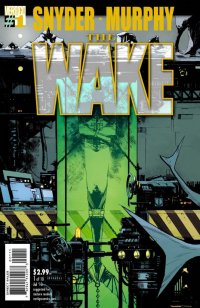 The Wake #1 ($2.99, Vertigo)
The Wake #1 ($2.99, Vertigo)
by D.S. Randlett (@dsrandlett)
It might seem strange coming from someone who frequents and contributes to a site called C.H.U.D., but horror has never been my genre. There are, unquestionably, films and novels in the genre that I love, but I don’t have the same ear for horror that many of the writers here have. With that said, I don’t know that I’ve ever really connected with a horror comic outside of Richard Corben’s work. Many writers and artists in the medium rely on the storytelling tropes, both technical and narrative, from other media. And while some of those tropes translate (much of Corben’s work is indebted to Nosferatu), many others do not. Comics for gorehounds end up lacking any of film’s grisly impact, while stories with a more tense slow burn feel fail to really grip, and I think that this is because creators are lifting examples from media where sound and camera movement are doing a lot of heavy lifting.
The Wake, while not the second coming of the horror comic or particularly scary yet (the eternal caveat of the first issue review), finds a few clever ways around this. In terms of story, it doesn’t feel like a horror book from the outset. The first pages feel like an adventure story, with a futuristic hang-gliding heroine and her dolphin companion exploring an abandoned, flooded city. After a quick shift to the present day, we get a mix of family drama and slow burn scifi. Snyder’s script succeeds as a genre work by basically not announcing itself.
Speaking of Scott Snyder, I sort of soured on his Batman work during Death of the Family. There we had a Joker story that was almost needlessly macabre, an attempt to examine and break open the relationship between Joker and Batman that relied on a mishmash of incomplete metaphors and themes concerning masks and identity. I was beginning to worry about Snyder there: previous stories in the series had a really good sense of mystery and a clear authorial voice. Happily, Snyder is back on form in The Wake. This first issue is pretty nuts and bolts stuff, but Snyder’s script has a sure hand for plot and character that makes the book’s amibitious, centuries-spanning mysteries compelling.
If the horror does not come through so strongly in the script, the type of horror that this series will likely center around is indicated by Sean Murphy’s (with some seriously great colors by Matt Hollingsworth) stellar art. Murphy’s layouts and compositions indicate, along with the oceanic setting, that we’ll be dealing with a Lovecraftian horror of the massive. A gigantic creature looms hidden beneath cresting waves on a splash page that must be seen to be believed, and even when characters in the present day are palling it up with humpback whales the oceans is a constant threatening presence. Murphy turns in some Eisner-worthy work here, and guarantees my continued purchase of this series.
The Wake is, as of its first issue, nothing revolutionary, but it appears to conceal some ambitions that it is confidently keeping under the table until the right time. Until then, it’s just damn solid.
Rating: 




Out of a Possible 5 Stars